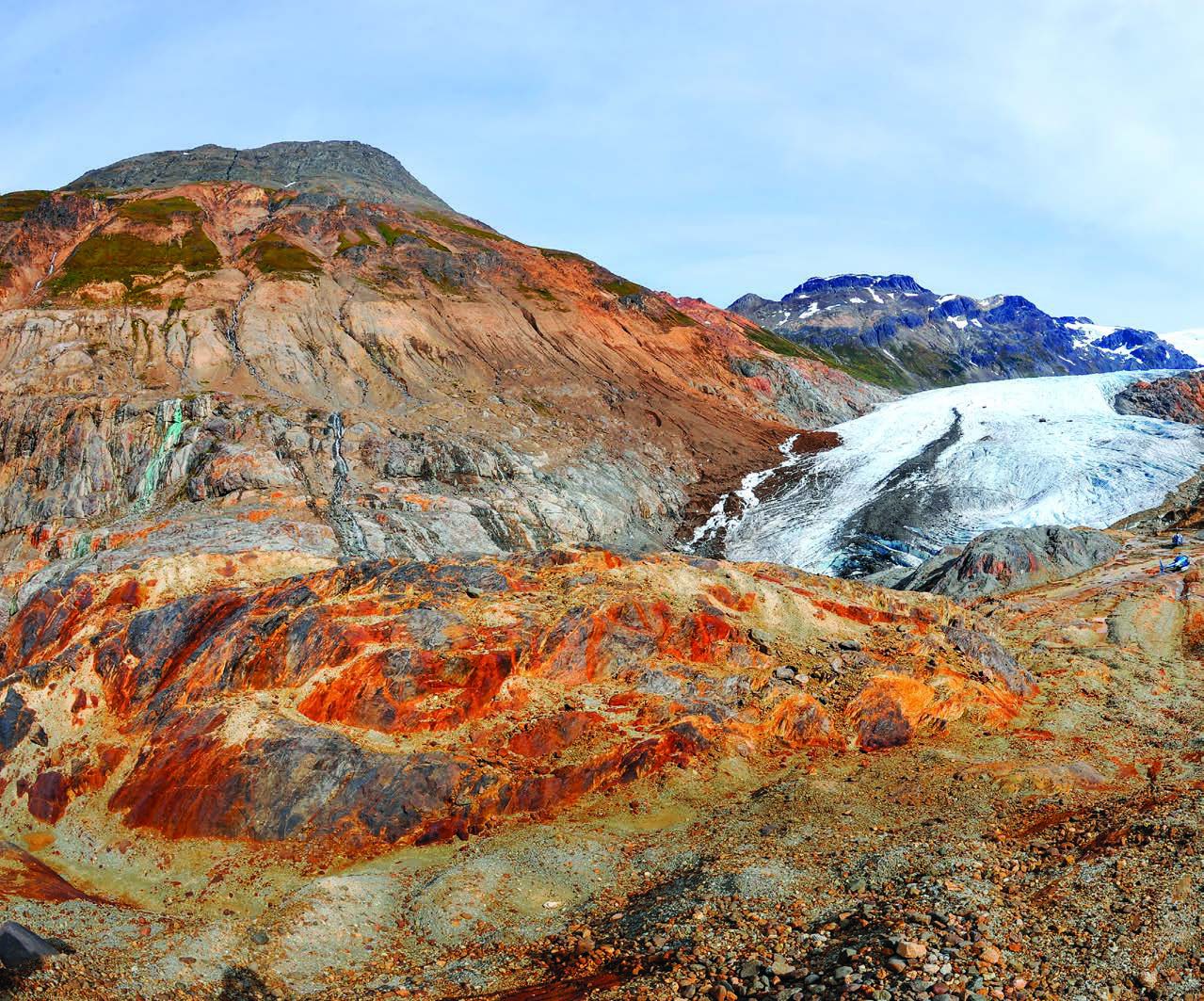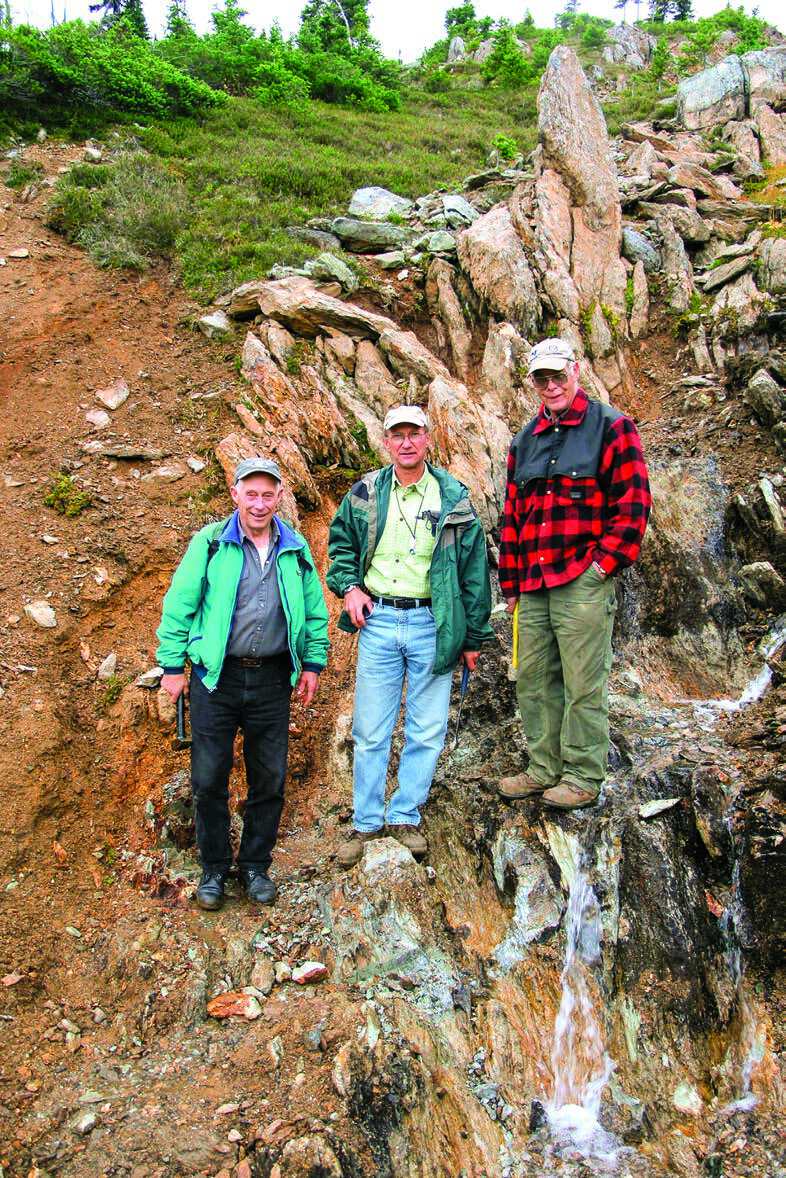
Top-10 lists are frequently contentious to compile, and this holds true for this assessment of the 10 greatest mineral deposit discoveries in British Columbia in the 35 years of Mineral Exploration magazine’s reporting. As many deposits were long known as showings or smallerscale resources before their true potential was discovered, we’ve defined a deposit’s discovery date as when something happened to declare it mineable. Many great B.C. deposits did not make this list as they were discovered before 1981, and there are several that were close (Snip being a notable mention), but in the end there was only room for 10.
1. Eskay Creek
Initially spearheaded by the great Murray Pezim in 1987, this world class deposit appears as a one-line note in the provincial government’s Exploration in British Columbia 1988 review. Therein, the author states that 2,438 metres of drilling had been completed, and under deposit type it just says “Vein?” It took over 100 drill holes to reveal the potential at Eskay Creek, with the now-famous 109th hole returning a 208-metre interval grading an average of 0.87 ounces gold, 0.97 ounces silver, 1.12 per cent lead and 2.26 per cent zinc. It has been subsequently identified as one of the most significant volcanic massive sulphide deposits in Canada and, although no longer in operation, Eskay Creek remains a jewel in B.C.’s mineral crown.
2. Brucejack
The story of how Brucejack went from being the target of early precious and base metals prospecting in the late 1880s to closing construction financing in 2015 is one of perfect timing. Many companies have looked at the area in the past, including Esso Minerals Canada Ltd., which explored the Brucejack Lake and West zones in the early 1980s, and the Newcana Joint Venture, which completed a feasibility study in the early 1990s. Silver Standard Resources Inc. acquired the property in the late 1990s, but it took some interest from outside parties to prompt exploration in the Snowfield area from 2006 to 2009. Finally, in 2009, Silver Standard discovered the Valley of the Kings zone, and Pretium Resources Inc. acquired the ![The Mitchell deposit at KSM, discovered by Seabridge Gold in 2006.]() project in 2010. This is where perfect timing comes in – in five years, Pretium has conducted an extensive exploration program on Valley of the Kings, completed a feasibility study outlining proven and probable mineral reserves of 6.9 million ounces of gold, obtained permits and commenced construction. The company is currently targeting a 2017 commercial production date and, if its track record continues, it will be right on time.
3. Red Chris
This is the first of several deposits on the list whose inclusion is based on the gamechanging discovery of deeper mineralization within the last 35 years. In the case of Red Chris, which was first delineated in the mid- to late-70s by Texasgulf Canada Ltd., the discovery that truly made this deposit came in 2007. Imperial Metals Corp., after much reassessment of previous geological work, decided to test the theory of deeper mineralization – subsequently intersecting 1.01 per cent copper and 1.26 grams per ton gold over 1,024.1 metres. Two years later, another deep hole intersected 647.5 metres grading 1.50 per cent copper and 2.68 grams per ton gold, confirming what had been missed by previous companies. Rumour has it that a visit from former Texasgulf personnel, which coincided with drilling of some of the more spectacular grades at Red Chris, was accompanied by much muttering along the lines of, “I told them we should have drilled deeper!”
4. Mount Milligan
The discovery of this deposit is a series of “might-not-have-beens” that were somehow all resolved. From mis-located claims and soil anomalies on maps to porcupine-munched core stacks, the initial early-1980s exploration of the area by Randy Farmer and Mark Rebagliati with Selco Inc. (a subsidiary of BP) was challenging. Subsequent adjacent staking by Richard Haslinger Sr. and much negotiation over pots of bonfire coffee led to an amalgamation of claims just in time for the project to be shelved by BP. Rebagliati went out to raise money for the project and finally found funding from Lincoln Resources. The first round of subsequent trenching and drilling did not result in a positive engineering report, but Rebagliati was sure there was something there and convinced Lincoln to fund another round of drilling. After hints of good results and a few lost holes, the final hole of the program hit, intersecting 1.64 grams per ton gold and 0.41 per cent copper over a 140-metre length. Those results attracted the interest of Bob Dickinson, a deal was cut, and it was full steam ahead with a further 720 drill holes. Rob Pease brought the property into development with Terrane Metals, and Mount Milligan was eventually taken over by its 10th company, Thompson Creek Metals, which produced the mine’s first copper-gold concentrate late in 2013 and reached its full production capacity in early 2015.
5. Kemess
The discovery of the Kemess deposits (North, South and East) is another story of determination and serendipity. Kemess North was the focus of intermittent exploration through the 1960s and 1970s, but it took the discovery of Kemess South to really drive focus in the area. Kemess South had itself been looked at in the early 1980s, with Anaconda Canada Ltd. and St. Philips Resources Ltd. both running core and reverse-circulation drill programs. However, as is so often the way, a combination of circumstances prevented this drilling from intersecting significant mineralization; some holes were drilled on the fringe of the deposit and some holes were cut short above high grade zones due to freeze-up ending the season. Subsequent work by the Kemess South Joint Venture (Kennecott Canada Exploration Inc./El Condor Resources Ltd.-St. Phillips Resources-Rio Algom Explorations Inc.), including geophysics and extensive drilling, culminated in the delineation of the deposit in 1993. Kemess South was subsequently mined, and Kemess North is now the focus of AuRico Metals Inc.’s proposed block cave project, Kemess Underground. Additional drilling by AuRico Metals has also led to the discovery of Kemess East, further highlighting the potential of this copper-gold camp.
6. Blackwater
This gold deposit was first hinted at through anomalous silver, zinc and lead in a Geological Survey of Canada regional stream sediment survey in 1973. Various geophysical surveys followed, and the first drilling of any sort took place in 1985. Insufficient results and a low gold price led to an exploration hiatus from 1997 to 2004, when Richfield Ventures Corp. and Silver Quest Resources Ltd. re-staked and consolidated the claims. A series of drill campaigns followed, and, in 2009, Richfield Ventures drilled hole BW-59 that intersected 329 metres averaging 1.25 grams per ton gold and 3.5 grams per ton silver. This discovery hole led to a joint venture between Silver Quest and Richfield with significant additional drilling, and a buyout of both companies by New Gold Inc. in 2011. New Gold subsequently completed resource delineation and a feasibility study in 2012 based on 310,000 metres of drilling. This discovery represents an emerging new mining district in a relatively underexplored region of British Columbia, earning it a place on this list.
7. Huckleberry

The success story of Huckleberry is one of those that keeps the exploration industry hoping and dreaming. Until 1993 it was a fairly conventional tale of companies doing a few years of work and finding a few things – in this case, Huckleberry’s Main Zone – but not enough to keep drilling. New Canamin Resources Ltd. optioned the property in 1992 and, like those who had come before, initially focused on the known Main Zone. It took a short hole drilled in 1993 for investigation of potential tailings disposal locations to intersect 0.905 per cent copper over eight metres to discover the East Zone. Through the rest of 1993 and 1994, a further 131 holes were drilled to outline the full extent of the deposit. Operations commenced in 1997 and Huckleberry has a current mine life to 2022 – all thanks to condemnation drilling. (On January 6, 2016, Huckleberry suspended its pit operations.)
8. KSM
The Kerr-Sulphurets-Mitchell project is as much a story of seeing potential as it is of discovering deposits. Individually, these deposits had all been known to some degree since at least the early 1980s. Placer Dome Inc. undertook considerable work from the late 1980s onwards, and had separately modelled both the Kerr and Sulphurets deposits. Seabridge Gold Inc. acquired the properties in 2001 and has completed significant amounts of exploration drilling since then. It has further delineated the Mitchell and Iron Cap deposits, and intersected additional mineralization at the appropriately named Deep Kerr deposit. Along with new discoveries, Seabridge has shown the potential to bring these deposits together into one cohesive and ambitious project. With a proposed 52-year mine plan, the KSM project will be a major source of employment in northwest B.C. well into the future.
9. Mount Polley
If there is one word to describe the development and ongoing operation of Mount Polley, it is “resilience.” It is difficult to pinpoint when exactly this deposit was discovered; an aeromagnetic anomaly was noted on a federal-provincial map in 1963. The site was the focus of a series of exploration programs by several different companies from 1966 to 1987 with a total of 33,736 metres of drilling completed in that time, but it took Imperial Metals (and an additional 27,566 metres of core) to make it economic. The mine went into production in 1997 but was placed on care and maintenance just four years later due to low metal prices. Exploration continued throughout the shutdown period and the mine was reopened in 2005. Drilling in 2010 intersected deeper mineralization, which subsequently led to plans for underground mining. Operations were again suspended in mid-2014 following a tailings dam breach but, after substantial and ongoing rehabilitation work, Mount Polley resumed modified operations in mid-2015. All indications are that this resilient deposit will continue to be an important contributor to B.C. for years to come.
10. New Afton
New Afton is another excellent example of how drilling deeper can change the path of a project. In this instance, it was the exploration of a worked-out deposit that had been left open to depth. It occupies the historic Afton Mine site, which operated from 1977 to 1997, and it is extracting deeper portions of that same deposit. New Afton has earned its place on this list as the only successful block cave mining operation in B.C. and as a significant current producer.
